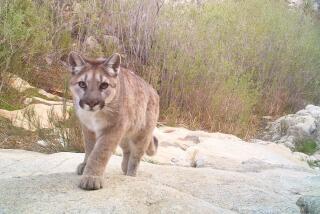Popular wolf killed by hunters in Yellowstone
For decades, the Western gray wolf has walked a fine line. Its numbers were once so diminished the creature was added to the federal government’s list of endangered species, only to be recently removed by Wyoming officials when those figures improved.
But the wolf isn’t out of the woods yet, a fact driven home last week when hunters shot and killed a popular wolf that was part of a tagging program run by rangers at Yellowstone National Park.
The 6-year-old wolf, a tourist favorite known as 832F, was the alpha female of Yellowstone’s “highly visible” Lamar Canyon pack, officials say. The animal had been fitted with a GPS collar that allowed researchers to track her movements.
In recent years, the U.S. Fish and Wildlife Service has transferred wolf management authority to states such as Idaho, Montana and Wyoming. Last fall, Wyoming allowed hunters to legally kill a limited number of the animals for the first time in decades. Ranchers say hunting is necessary to keep wolves from raiding domestic livestock, but the new hunting allowance has taken a toll on Yellowstone’s tagged wolf population.
Wolf 832F, which was so well-known that park workers called her Rock Star, was the eighth wolf fitted with a GPS collar to be shot during this year’s hunting season, officials say.
Last week, the Humane Society of the United States and the Fund for Animals filed a lawsuit in federal court challenging the decision of the U.S. Fish and Wildlife Service to transfer wolf management authority to states, calling the move “biologically reckless.”
“Wyoming’s regressive wolf management plan is reminiscent of a time when bounties paid by state and federal governments triggered mass killings that nearly exterminated wolves from the lower 48 states,” Jonathan Lovvorn, senior vice president and chief counsel for animal protection litigation at the Humane Society, said when the lawsuit was filed.
At least 50 wolves have been killed in the state since Oct. 1, the lawsuit says.
On Monday, Montana wildlife commissioners temporarily shut down the gray wolf hunting season in some areas outside Yellowstone, saying the move was a reaction to the killing of 832F and other tagged wolves that wandered out of the national park.
But animal advocates say the move doesn’t go far enough.
“The Montana commissioners themselves say this move is not meant to be permanent,” Ralph Henry, director of litigation for the Humane Society, told the Los Angeles Times. “We’re happy to see Montana respond in a way to protect the wolves, but it’s frustrating to see this happen in a manner that’s reactive rather than proactive.”
Montana, Idaho and Wyoming now have programs allowing wolf hunts. Wildlife advocates are particularly critical of the Wyoming effort, saying it removed the most protections for wolves.
“We’ve challenged the Wyoming plan in court because it’s the most reckless,” Henry said. “But other collared wolves in heavily researched packs have been killed as soon as they stepped across the border into Montana and Idaho. Rock Star’s killing is another example why it’s important for all three states in the region to have a management plan that allows for sufficient dispersal of wolves throughout the area.”
Currently, more than 1,700 wolves wander the Rocky Mountain region, according to National Park Service estimates, most of them in Idaho. In Yellowstone alone, according to the park’s annual wolf report, there were at least 98 wolves in 10 packs — plus two loners — at the end of 2011.
But none as well known as 832F.
ALSO:
Hypnosis OKd for sergeant charged in Army clinic killings
Colorado governor gives pot smokers an early gift: legality
Powerball’s $192 million: Does it matter which Arizona man won?
More to Read
Start your day right
Sign up for Essential California for news, features and recommendations from the L.A. Times and beyond in your inbox six days a week.
You may occasionally receive promotional content from the Los Angeles Times.







